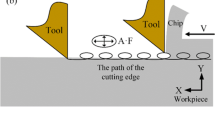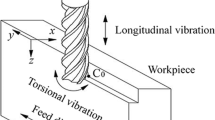Abstract
Ti-6Al-4 V alloy is growing used in the fields of aerospace, automobile and medical industries, and the requirement for machining accuracy of those parts is also increasing. However, it is difficult to achieve ultra-precision cutting of titanium alloy with traditional manufacture techniques. The ultrasonic elliptical vibration assisted cutting (UEVC) is considered the promising manufacture strategy for ultra-precision cutting of Ti-6Al-4 V alloy. Remarkably, under the ultra-precision cutting scale, the detrimental effect of vibration texture caused by UEVC process on surface roughness should not be ignored. In this paper, the theoretical analysis and experimental studies on the influence of process parameters on the surface roughness were carried out for suppressing the adverse effects of vibration texture and improving the machined surface quality. The influence of vibration amplitudes in cutting and cutting depth directions, tool edge radius, cutting speed, and feed rate on the surface roughness was clarified. An ultra-precision machined surface of Ti-6Al-4 V alloy (Ra < 30 nm) was obtained, when the optimal process parameters were adopted. The research results indicated that the use of optimal process parameters can suppress the adverse effect of vibration texture on surface roughness and simultaneously retain the technical advantages of UEVC process.











Similar content being viewed by others
References
Lee Y, Kim ES, Park S, Park J, Seol J, Kim H, Lee T, Sung H, Kim J (2022) Effects of laser power on the microstructure evolution and mechanical properties of Ti–6Al–4 V alloy manufactured by direct energy deposition. Met Mater Int 28:197–204. https://doi.org/10.1007/s12540-021-01081-9
Qin S, Peng Z, Shi X, Xue Y, Zhang K, Huang Q (2022) Optimization of textured parameters to improve the tribological behavior of TC4-based bionic coating using RSM. Tribol Trans 65(3):441–456. https://doi.org/10.1080/10402004.2022.2040674
Yip WS, To S (2019) Effects of magnetic field on microstructures and mechanical properties of titanium alloys in ultra-precision diamond turning. Mater Res Express 6(5):056553. https://doi.org/10.1088/2053-1591/ab069e
Hu K, Lo SL, Wu H, To S (2019) Study on influence of ultrasonic vibration on the ultra-precision turning of Ti6Al4V alloy based on simulation and experiment. IEEE Access 7:33640–33651. https://doi.org/10.1109/ACCESS.2019.2896731
Shore P, Morantz P (2012) Ultra-precision: enabling our future. Philos Trans R Soc A-Math Phys Eng Sci 370:3993–4014. https://doi.org/10.1098/rsta.2011.0638
Liu Q, Cheng J, Liao Z, Luo X, Yang Y, Li M, Yang H, Tan C, Wang G, Ding W, Yin Z, Zhao L, Chen M (2023) Research on the light intensity modulation and characterizing methods of surface texture on KDP optics generated in fly-cutting and micro ball-end milling processes. CIRP J Manuf Sci Technol 41:30–43. https://doi.org/10.1016/j.cirpj.2022.11.013
Zhang J, Lu S, Shi G, Xie W, Geng Y, Wang Z (2022) A study on a hybrid SERS substrates based on arrayed gold nanoparticle/graphene/Copper cone cavities fabricated by a conical tip indentation. J Mater Res Technol-JMRT 22:1558–1571. https://doi.org/10.1016/j.jmrt.2022.12.001
Yip WS, To S (2019) Reduction of minimum cutting thickness of titanium alloys in micro cutting by a magnetic field assistance. IEEE Access 7:152034–152041. https://doi.org/10.1109/ACCESS.2019.2945526
Silva RB, Machado AR, Ezugwu EO, Bonney J, Sales WF (2013) Tool life and wear mechanisms in high speed machining of Ti-6Al-4V alloy with PCD tools under various coolant pressures. J Mater Process Technol 213(8):1459–1464. https://doi.org/10.1016/j.jmatprotec.2013.03.008
Ni C, Zhu L, Zheng Z, Zhang J, Yang Y, Yang J, Bai Y, Weng C, Lu WF, Wang H (2020) J Alloy Compd 848:156457. https://doi.org/10.1016/j.jallcom.2020.156457
Lucca DA, Klopfstein MJ, Riemer O (2020) Ultra-precision machining: cutting with diamond tools. J Manuf Sci Eng 142(11):110817. https://doi.org/10.1115/1.4048194
San HJ, Zhang YX, Chen MF, Hao W (2018) Research on an ultrasonic cutting device based on 0Cr18Ni9. Shock Vib 2515239. https://doi.org/10.1155/2018/2515239
Yin S, Dong ZG, Bao Y, Kang RK, Du WH, Pan YN (2021) Development and optimization of ultrasonic elliptical vibration cutting device based on single excitation. J Manuf Sci Eng-Trans ASME 143(8):081005. https://doi.org/10.1115/1.4049965
Khajehzadeh M, Boostanipour O, Amiri S, Razfar MR (2020) The influence of ultrasonic elliptical vibration amplitude on cutting tool flank wear. Proc Inst Mech Eng Part B-J Eng Manuf 234:1499–1512. https://doi.org/10.1177/0954405420929782
Dai HF, Chen JJ, Liu GJ (2019) A numerical study on subsurface quality and material removal during ultrasonic vibration assisted cutting of monocrystalline silicon by molecular dynamics simulation. Mater Res Express 6:065908. https://doi.org/10.1088/2053-1591/ab0ccb
Tan RK, Zhao XS, Zhang S, Zou XC, Guo SS, Hu ZJ, Sun T (2019) Study on ultra-precision processing of Ti-6Al-4 V with different ultrasonic vibration assisted cutting modes. Mater Manuf Process 34(12):1380–1388. https://doi.org/10.1080/10426914.2019.1660788
Tan RK, Zhao XS, Guo SS, Zou XC, He Y, Geng YQ, Hu ZJ, Sun T (2020) Sustainable production of dry-ultra-precision machining of Ti–6Al–4 V alloy using PCD tool under ultrasonic elliptical vibration assisted cutting. J Clean Prod 248:119254. https://doi.org/10.1016/j.jclepro.2019.119254
Lin JQ, Guan L, Lu MM, Han JG, Feng D (2017) Research on the effect of cutting parameters on chip formation and cutting force in elliptical vibration cutting process. Mater Sci Eng 274:0121426. https://doi.org/10.1088/1757-899X/274/1/012142
Zhou JK, Lu MM, Lin JQ, Du YS (2021) Elliptic vibration assisted cutting of metal matrix composite reinforced by silicon carbide: an investigation of machining mechanisms and surface integrity. J Mater Res Technol-JMRT 15:1115–1129. https://doi.org/10.1016/j.jmrt.2021.08.096
Zhou J, Lu M, Lin J, Zhou X, Guo M, Du Y (2022) Investigation of surface integrity transition of SiCp/Al composites based on specific cutting energy during ultrasonic elliptical vibration assisted cutting. J Manuf Process 79:654–665. https://doi.org/10.1016/j.jmapro.2022.04.067
Moriwaki T, Shamoto E (1995) Ultrasonic elliptical vibration cutting. CIRP Ann-Manuf Technol 44(1):31–34. https://doi.org/10.1016/S0007-8506(07)62269-0
Li X, Zhang D (2009) Research on micro-surface formation mechanism of uItrasonic elliptical vibration cutting. China Mech Eng 7:54–58. http://www.cmemo.org.cn/EN/abstract/abstract1293.shtml. Accessed 10 Apr 2009
Zhang XQ, Kumar AS, Rahman M, Liu K (2013) Modeling of the effect of tool edge radius on surface generation in elliptical vibration cutting. Int J Adv Manuf Technol 65:35–42. https://doi.org/10.1007/s00170-012-4146-8
Sajjady SA, Abadi HNH, Amini S, Nosouhi R (2016) Analytical and experimental study of topography of surface texture in ultrasonic vibration assisted turning. Mater Des 93:311–323. https://doi.org/10.1016/j.matdes.2015.12.119
Kim GD, Loh BG (2013) Cutting force variation with respect to tilt angle of trajectory in elliptical vibration V-grooving. Int J Precis Eng Manuf 14(10):1861–1864. https://doi.org/10.1007/s12541-013-0249-x
Zhang JG, Zhang JJ, Cui T, Hao ZW, Al Zahrani A (2017) Sculpturing of single crystal silicon microstructures by elliptical vibration cutting. J Manuf Process 29:389–398. https://doi.org/10.1016/j.jmapro.2017.09.003
He Y, Zou P, Zhu WL, Ehmann KF (2017) Ultrasonic elliptical vibration cutting of hard materials: simulation and experimental study. Int J Adv Manuf Technol 91:363–374. https://doi.org/10.1007/s00170-016-9716-8
Usman MM, Zou P, Tian YJ, Wang WJ (2020) Experimental investigation on surface functional indices in Ultrasonic Elliptical Vibration Cutting of C45 carbon steel. Int J Adv Manuf Technol 109:187–200. https://doi.org/10.1007/s00170-020-05661-8
Zhang XQ, Liu K, Kumar AS, Rahman M (2014) A study of the diamond tool wear suppression mechanism in vibration assisted machining of steel. J Mater Process Technol 214:496–506. https://doi.org/10.1016/j.jmatprotec.2013.10.002
Tan RK, Zhao XS, Sun T, Zou XC, Hu ZJ (2019) Experimental investigation on micro-groove manufacturing of Ti-6Al-4V alloy by using ultrasonic elliptical vibration assisted cutting. Materials 12:3086. https://doi.org/10.3390/ma12193086
Funding
This paper is funded by the Open Project of Key Laboratory of Conveyance Equipment (East China Jiaotong University), Ministry of Education (Grant No. KLCE2021-09), the Science and Technology Research Project of Jiangxi Provincial Department of Education (Grant No. GJJ210641), the Open Project of Henan Province Engineering Research Center of Ultrasonic Technology Application (Grant No. PXY-JXKFJJ-202101), and the Science Challenge Project of China (Grant No. TZ2018006-0202).
Author information
Authors and Affiliations
Contributions
Rongkai Tan: conceptualization, methodology, supervision, writing-review and editing. Xianmin Guo and Xin Chen: formal analysis, writing-original draft. Shijing Jin: visualization, software. Fengtao Lin: investigation, data curation. Xuesen Zhao: investigation. Tao Sun: resources.
Corresponding authors
Ethics declarations
Ethical approval
Not applicable.
Consent to participate
Not applicable.
Consent for publication
All authors have read and agreed to the published version of the manuscript.
Conflict of interest
The authors declare no competing interests.
Additional information
Publisher's Note
Springer Nature remains neutral with regard to jurisdictional claims in published maps and institutional affiliations.
Rights and permissions
Springer Nature or its licensor (e.g. a society or other partner) holds exclusive rights to this article under a publishing agreement with the author(s) or other rightsholder(s); author self-archiving of the accepted manuscript version of this article is solely governed by the terms of such publishing agreement and applicable law.
About this article
Cite this article
Tan, R., Zhao, X., Lin, F. et al. Analytical modelling and experimental study of surface roughness in ultrasonic elliptical vibration assisted ultra-precision cutting of Ti-6Al-4 V alloy. Int J Adv Manuf Technol 126, 1863–1875 (2023). https://doi.org/10.1007/s00170-023-11261-z
Received:
Accepted:
Published:
Issue Date:
DOI: https://doi.org/10.1007/s00170-023-11261-z




